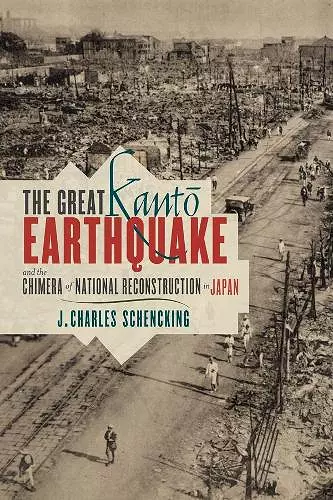The Great Kantō Earthquake and the Chimera of National Reconstruction in Japan
Format:Hardback
Publisher:Columbia University Press
Published:12th Jul '13
Currently unavailable, and unfortunately no date known when it will be back

This fascinating, original book is the first work in English to offer a comprehensive account of the Kanto earthquake. The book could not be timelier. J. Charles Schencking crafts an enticing lead-in, illuminating the uncanny resemblances in how Japanese talked about both the Kanto earthquake and the 2011 earthquake/tsunami as opportunities to revitalize the nation. -- Sheldon Garon, Princeton University, author of Beyond Our Means: Why America Spends While the World Saves
In September 1923, a magnitude 7.9 earthquake devastated eastern Japan, killing more than 120,000 people and leaving two million homeless. Using a rich array of source material, J. Charles Schencking tells for the first time the graphic tale of Tokyo's destruction and rebirth. In emotive prose, he documents how the citizens of Tokyo experienced this unprecedented calamity and explores the ways in which it rattled people's deep-seated anxieties about modernity. While explaining how and why the disaster compelled people to reflect on Japanese society, he also examines how reconstruction encouraged the capital's inhabitants to entertain new types of urbanism as they rebuilt their world. Some residents hoped that a grandiose metropolis, reflecting new values, would rise from the ashes of disaster-ravaged Tokyo. Many, however, desired a quick return of the city they once called home. Opportunistic elites advocated innovative state infrastructure to better manage the daily lives of Tokyo residents. Others focused on rejuvenating society-morally, economically, and spiritually-to combat the perceived degeneration of Japan. Schencking explores the inspiration behind these dreams and the extent to which they were realized. He investigates why Japanese citizens from all walks of life responded to overtures for renewal with varying degrees of acceptance, ambivalence, and resistance. His research not only sheds light on Japan's experience with and interpretation of the earthquake but challenges widespread assumptions that disasters unite stricken societies, creating a "blank slate" for radical transformation. National reconstruction in the wake of the Great Kanto Earthquake, Schencking demonstrates, proved to be illusive.
A gracefully written and searching analysis that places Japan's deadliest earthquake in historical context. An important contribution to the literature on natural disaster that moves beyond the cliches often told about reconstruction. -- Ted Steinberg, Case Western Reserve University In vivid detail, this timely book explores the many ways the Japanese responded to the earthquake of 1923-from debates about the meaning of the disaster through representations of the event in popular culture and the rough-and-tumble politics of reconstruction. Deeply researched and well written, it is a major contribution to the urban history of modern Japan as well as to the burgeoning field of disaster studies. -- Peter Duus, Stanford University Writing in compelling detail, Schencking draws on a broad array of contemporary sources...Highly recommended. Choice A comprehensive account of what happened in 1923... Schencking has artfully combined first-person narratives with media reports and statistics. -- Julian Ryall South China Morning Post [Schencking] is to be commended for his painstaking research. -- Stephen Mansfield The Japan Times Wonderfully illustrative... J. Charles Schencking does an excellent job of analyzing not merely the events, aftermath, and reconstruction of Tokyo following the epic disaster of September 1, 1923, but also the cacophony of voices and competing agendas that devoured much of the initial enthusiasm behind the project. Environmental History Schencking has... an enviable eye for detail and... prose that is positively poetic... An excellent book... Our understanding of Taisho Japan will only be the richer for Schencking's efforts. -- Peter Mauch, University of Western Sydney Japanese Studies A meticulous study... The Great Kanto Earthquake is a superb work of historical scholarship and a major contribution to our understanding of modern Japan and modern natural disasters. -- Gregory Smits, Penn State University Journal of Japanese Studies This meticulously researched monograph not only provides a rare picture of how Taisho Japan worked and saw itself, but also casts a sobering light on contemporary expectations that 3.11 will necessarily transform Japan into a stronger, greener, and denuclearized country. -- Andre Haag Pacific Affairs A compelling narrative history as well as a satisfying analytic one... tenaciously researched, imaginatively argued, and carefully crafted. -- Mark Jones The Journal of Asian Studies
ISBN: 9780231162180
Dimensions: unknown
Weight: unknown
400 pages